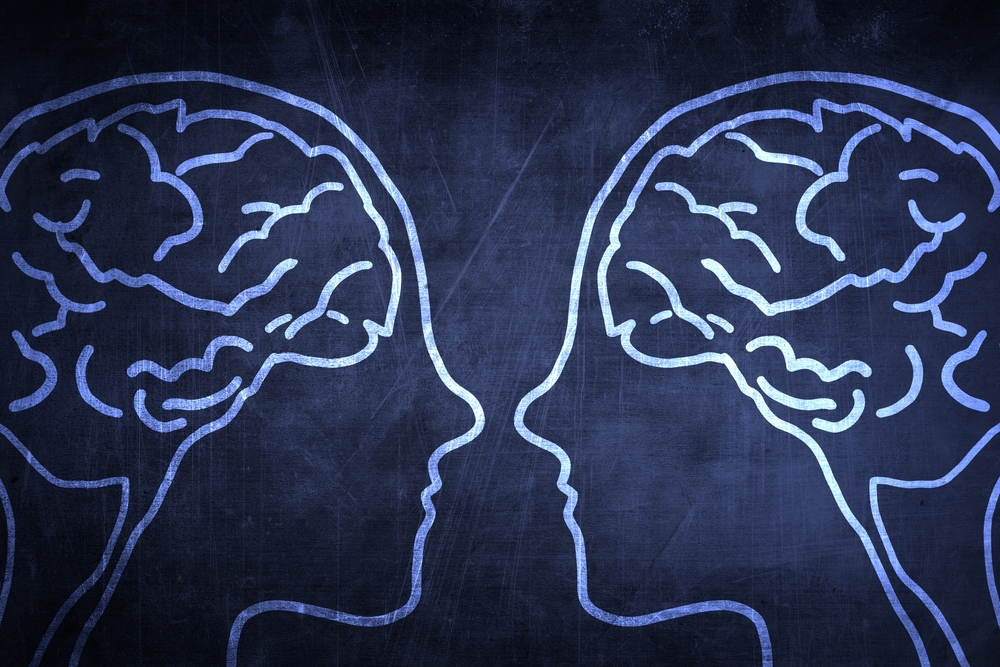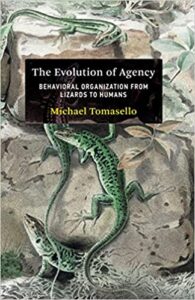Cooperation Requires Large Brains
By Arnold Kling


- The foundation stone of uniquely human agency is individuals’ ability and propensity to form with others a joint goal, thereby creating an evolutionarily unique, socially constituted feedback control system.
- ——Michael Tomasello, The Evolution of Agency: Behavioral Organization from Lizards to Humans.1 (Page 97)
Tomasello describes experimental results comparing chimpanzees with human children:
- First, if a chimpanzee is collaborating with a partner and unexpectedly gets her reward first, she simply takes it and runs; in contrast, if a young human child gets her reward first, she nevertheless stays committed to the collaboration throughout, delaying cashing in her own reward until her partner gets hers as well. Second, when a collaboration has reached its joint goal, a dominant chimpanzee will, if possible, hog all the spoils and exclude her partner, which means that the pair is unlikely to continue collaborating; in contrast, when a young human child obtains rewards collaboratively with a partner, she almost always divides them equally, which encourages continuing collaboration. (p. 96, references omitted)
Agency, as Tomasello describes it, is a feedback control system. An agent has a goal, it takes actions in pursuit of that goal, it assesses whether those actions are moving toward the goal as expected, and if it is off track it alters those actions.
- The concept of agency thus, in a sense, represents the dividing line between biological and psychological approaches to behavior; it is the distinction between complex behaviors designed and controlled by Nature, as it were, versus those designed and controlled, at least to some degree, by the individual psychological agent. (p. 6)
A feedback control system acts like a thermostatically controlled heating system. You set a target temperature for your heating system, it pushes warm air in order to achieve that temperature, and until that temperature is reached, it keeps adding warm air.
But I would not say that the heating system has agency. A thermostatically controlled heating system is designed and manufactured by a firm and is controlled by the consumer. It has no autonomy. In the animal kingdom, creatures may be “designed” by evolutionary processes, but they are not manufactured. They have some degree of individual autonomy.
Tomasello refers to human cooperation as joint agency, shared agency, or socially normative agency. He argues that joint agency is the end result of an evolutionary process affecting animal brains that took place in four stages.
According to Tomasello, early vertebrates were able to set goals, rather than merely react to stimuli. He calls this goal-directed agency. Early small mammals were able to change strategies for achieving goals. He calls this intentional agency. Ancient apes could make predictions about other animals’ behavior based on their own propensities. He calls this rational agency. Finally, humans were able to work with one another to achieve a joint goal. He calls this shared agency. At each stage of the evolution of agency, an additional layer of cognitive capacity had to be added to our brains.
I will focus narrowly on shared agency. Shared agency means that you and I both understand that we are acting in pursuit of a goal.
Suppose that I say, “Look to your left.” You choose to do so, because you believe that we have a common goal that is served if you look to your left. Looking to your left is not a reflex. A dog might be trained to obey a command “look to your left.” But I can use completely different words, such as “I see a deer in those trees,” which a trained dog would not recognize. Or I could merely point in that direction. Tomasello sees pointing as an example of a linguistic communication skill that other animals lack, because it requires a brain capable of shared agency.
Shared agency leads to rich communication skills. These include using language for deceptive purposes. I could say “Look to your left” to distract you while I take your wallet.
Why did agency evolve? Tomasello emphasizes that evolved capacities would not just have appeared out of nowhere. Selection pressure must be at work:
- The evolutionary hypothesis is that when individuals regularly face situations of uncertainty, the individuals that fare best are those that operate agentively to flexibly assess the situation at hand and make a decision informed by the relevant local contingencies…. My more specific evolutionary hypothesis is that the four main types of agentive organization on the way to contemporary humans evolved in response to four main types of uncertainties, created mainly by four different types of social interaction. (p. 12-13)
The first layer of the brain evolved in response to uncertainty about where food might be found. A second layer was added in response to uncertainty about which path to food would be most successful. A third layer was added in response to the need to compete with other creatures for food.
Humans evolved in a context in which increased crowding elevated the challenges of foraging for food. To meet those challenges, humans learned to collaborate. Tomasello believes that this evolution took place in two steps:
- The initial step was early human individuals (before the emergence of Homo sapiens) coming to collaborate with one another in face-to-face interactions to pursue collaborative goals, especially in the context of foraging. Early human individuals formed with other individuals a joint agency. The second step was modern humans (early Homo sapiens sapiens, before agriculture and civilization) coming to form distinct cultural groups, each pursuing its own collective goals with its own cultural practices. Modern human individuals formed with others in their cultural group a collective agency. (p. 91-92)
The cognitive requirements for shared agency are steep:
- What could be riskier and more uncertain than forgoing pursuit of one’s own individual goal to try to align and coordinate toward a common goal with a partner who has her own individual goals and values? And the risks and uncertainties are only magnified when the “partner” is an entire cultural group. Making these new socially constituted forms of agency work thus required ancestral humans to develop both new skills of social coordination and new social motivations.
(p. 92)
I would propose that a third step was required when humans formed large collective entities, such as cities. That step was the development of formal rules. Informal norms and social pressure are adequate for regulating behavior among people who know one another. The Dunbar number suggests that this would apply in groups of about 150 or less. For larger entities, explicit laws and well-defined roles are necessary. A small start-up business does not need an organization chart or a written procedures manual. A large, established business cannot get along without such formal elements.
By the time we reached this third step, human development consisted more of cultural evolution as opposed to basic biological changes to our brains. Cultural evolution continues, and at a far faster rate than biological evolution.
For more on these topics, see
- “The Social Learning Animal,” by Arnold Kling. Library of Economics and Liberty, Jun. 5, 2017.
- “A WEIRD Turn in Social Science,” by Arnold Kling. Library of Economics and Liberty, Nov. 2, 2020.
- “The Fundamental Rule of Social Morality,” by Arnold Kling. Library of Economics and Liberty, Sep. 7, 2015.
Many important cognitive skills serve the purpose of collaboration. A long period of childhood enables a new human to acquire cultural knowledge before dealing with adult problems. The ability to recall the past and plan for the future enables more complex forms of collaboration. The ability to produce written records enables us to make long-term agreements and bring cultural knowledge into the future.
- Michael Tomasello’s book, The Evolution of Agency, 5/16/23. YouTube.
Unfortunately, each stage of cultural evolution only solves some problems. Other problems persist. We still have conflicts between individuals. We still have conflicts between cultural groups. New cultural tools can sometimes help us to mitigate conflicts, but it seems that new ideas and technologies can just as easily exacerbate conflicts.
Footnotes
[1] Michael Tomasello, The Evolution of Agency: Behavioral Organization from Lizards to Humans. MIT Press, 2022.
*Arnold Kling has a Ph.D. in economics from the Massachusetts Institute of Technology. He is the author of several books, including Crisis of Abundance: Rethinking How We Pay for Health Care; Invisible Wealth: The Hidden Story of How Markets Work; Unchecked and Unbalanced: How the Discrepancy Between Knowledge and Power Caused the Financial Crisis and Threatens Democracy; and Specialization and Trade: A Re-introduction to Economics. He contributed to EconLog from January 2003 through August 2012.
Read more of what Arnold Kling’s been reading. For more book reviews and articles by Arnold Kling, see the Archive.
